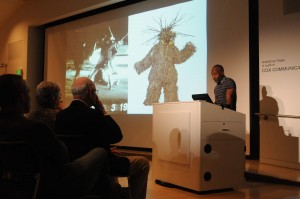Stand and deliver? Rethinking the lecture format
14 April 2012 – Meghan Gelardi Holmes
What is the best way of conveying information to an audience? This question is a perennial favorite among academics, who regularly debate the efficacy of lectures as a teaching tool. It’s an increasingly common question in the museum setting too, as more museums embrace participatory projects and initiatives.
At the small art museum where I work, we regularly confront this question when designing public programs for adults. We try very hard to make a range of options available for our visitors to interact with the artworks and digest the themes of each exhibition, including performances, art-making activities, and creative tours. Lectures still work for plenty of our visitors, however. When we find the right speaker or the right topic, the presentation can be informative and sometimes even inspiring. (That is the model TED Talks are built on.) At the same time, we can’t always be sure that the message or themes we hope to convey are received. And, let’s be honest, dynamic presenters are hard to come by.
One of my major challenges in determining which programs are appropriate for our visitors is, of course, figuring out what they want to experience at the museum. And often, adult audiences prefer the format of a lecture over a participatory experience. Although we know people tend to retain information better when they are part of a dialogue or other activity, there is a very real energy barrier to participating in these more involved programs.
I’m not immune to this myself. Recently, I took a trip to a nearby museum for a special thematic tour. I was expecting a long presentation where I could sit passively and absorb the information; what I got was an extended dialogue program. It was a bit uncomfortable at first, but the themes and concepts stayed with me for much longer because of the participatory format. The energy barrier is real, but so is the reward on the other side.
How do we encourage the museum visitor to welcome the benefits of a participatory museum experience? Although I’m a firm believer in the power of active engagement, I find I need to bring my audience along slowly. And so, we’ve diversified our programs – facilitating dynamic conversations between two speakers or using the exhibitions as illustrations for a talk – without entirely doing away with lecture-style presentations. Recently, we offered a hands-on workshop with a guest artist, with a public demonstration component. This made room for those visitors who might want to learn more about the artist’s process, but weren’t quite ready to dig in and get their hands dirty. It worked really well, and we broadened our definition of what participation can mean.
For me, the tougher question to answer is this: as museum educators, how do we overcome our inclination to default to traditional methods of content delivery? Lectures are familiar. For many of us recently out of graduate school, distinguished lecture series and symposia are our programming standard bearers. Not to mention how much easier it can be to put together a lecture over a participatory experience. My current strategies: planning way, way ahead of the game for participatory projects, and not becoming too discouraged when the balance swings too far in the opposite direction.
How do you meet these challenges in your institution?
~ Meghan Gelardi Holmes is the Curatorial Assistant for Adult Education at the Taubman Museum of Art, where she plans public programs and participatory art experiences for a range of adult audiences in the Roanoke area. Before moving to Virginia, she ran the first-year seminar program at Rutgers, The State University of New Jersey. Holmes received an MA in Public History from the University of Massachusetts-Amherst in 2006. She was the Skinner Museum Assistant Curator at the Mount Holyoke College Art Museum, where she fell in love with cabinets of curiosity and the life of objects. She also worked as the Assistant Director of a Teaching American History project, helping connect K-12 teachers with local history organizations across western Massachusetts.




